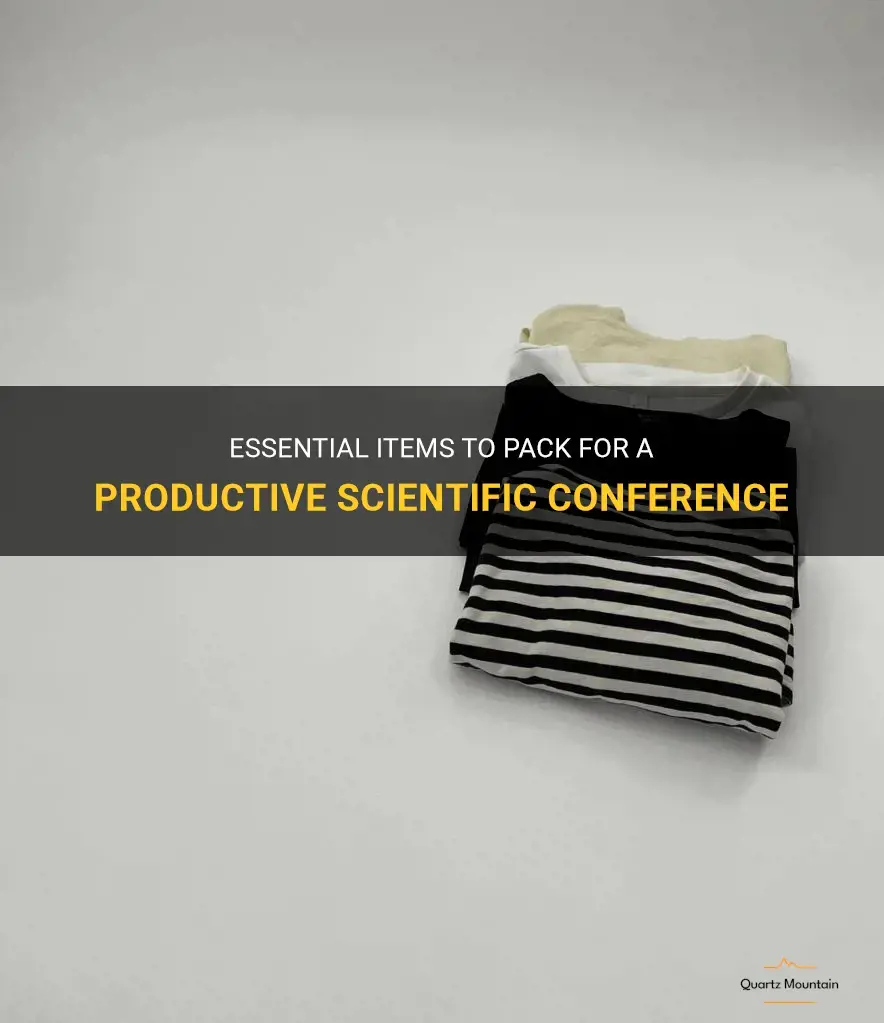
Attending a scientific conference can be a thrilling experience, providing opportunities to network with fellow researchers, learn about the latest developments in your field, and showcase your own work. But amidst the excitement and busy agenda, it's crucial to have all the essential items that enhance your productivity and make your conference experience seamless. From the indispensable tech gadgets to the must-have stationery, we'll dive into the key items you should pack to ensure a productive scientific conference. So grab your notepad and digital devices, and get ready to make the most out of your conference journey.
What You'll Learn
- What are the essential items to pack for a scientific conference?
- Are there any specific dress code requirements for scientific conferences?
- Should I bring my laptop or tablet to a scientific conference?
- What type of footwear is most suitable for a scientific conference?
- Are there any recommended items to bring for networking and socializing at a scientific conference?

What are the essential items to pack for a scientific conference?
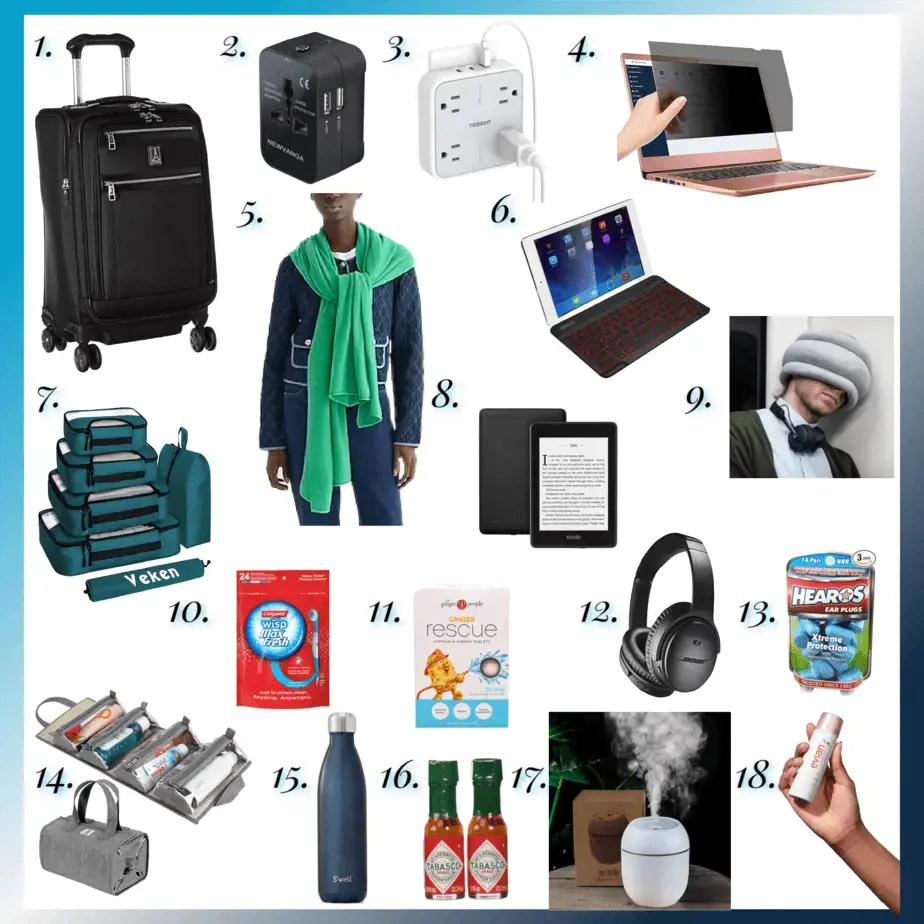
Attending a scientific conference can be an exciting and rewarding experience for researchers and professionals in various scientific fields. Whether you are presenting your own research or simply attending to learn and network, it is important to be prepared and pack the essential items for a successful conference. In this article, we will discuss the key items you should consider packing when attending a scientific conference.
- Research materials: If you are presenting your own research, it is crucial to bring all the materials related to your presentation. This includes copies of your research paper, slides or posters, and any other visual aids you may have prepared. Additionally, it is a good idea to print out extra copies of your research to distribute to interested colleagues or potential collaborators.
- Business cards: Networking is a major component of any conference, so it is important to have your contact information readily available. Business cards are a professional and convenient way to exchange contact details with fellow researchers. Be sure to include your name, affiliation, email, and phone number on your business cards.
- Writing materials: Pack a notebook and pens to take notes during presentations and discussions. You never know when inspiration may strike or when you'll want to jot down important points. Writing materials also come in handy when exchanging information with other attendees or when engaging in impromptu brainstorming sessions.
- Comfortable attire: Conferences often involve long hours of sitting and walking, so it is important to dress comfortably. Opt for business casual attire that is both professional and comfortable. Keep in mind that conference rooms can be quite cold, so a sweater or light jacket can come in handy.
- Laptop or tablet: Many conferences provide attendees with access to Wi-Fi and offer opportunities for interactive sessions. Bringing a laptop or tablet allows you to stay connected, take advantage of online resources, and participate in virtual sessions or workshops. It's also a convenient way to keep your research materials organized and easily accessible.
- Power bank and chargers: Conferences can be exhausting, and your devices may run out of battery just when you need them the most. Having a portable power bank and all the necessary chargers ensures that you can stay connected throughout the conference without worrying about your devices dying.
- Comfortable shoes: Conferences often involve a lot of walking and standing, so make sure to pack comfortable shoes. Opt for shoes that provide good support to avoid discomfort or potential foot pain. You'll be glad you did when you're on your feet for long periods of time.
- Snacks and water: Conferences can be busy, and it's easy to forget to eat or stay hydrated. Packing some light snacks like energy bars or nuts can help keep your energy levels up throughout the day. Additionally, bring a reusable water bottle to stay hydrated and reduce waste from single-use plastic bottles.
- Medications and personal essentials: Don't forget to pack any necessary medications or personal essentials that you may need during the conference. This includes any prescription medications, over-the-counter remedies, and personal hygiene products.
- Open mind and enthusiasm: Lastly, bring an open mind and enthusiasm for learning and engaging with fellow researchers. Conferences offer a wealth of knowledge and networking opportunities, so embrace the experience and make the most out of it.
In conclusion, packing the essential items for a scientific conference can greatly enhance your overall experience. Remember to bring all the necessary research materials, business cards, writing materials, and electronic devices. Don't forget to dress comfortably, pack snacks, and stay hydrated. Most importantly, approach the conference with an open mind and enthusiasm for learning. By being prepared, you can make the most out of your conference experience and create valuable connections and opportunities in your field of research.
The Ultimate Packing Guide: What to Pack in Your Backpack for a 6-Week Trip
You may want to see also

Are there any specific dress code requirements for scientific conferences?
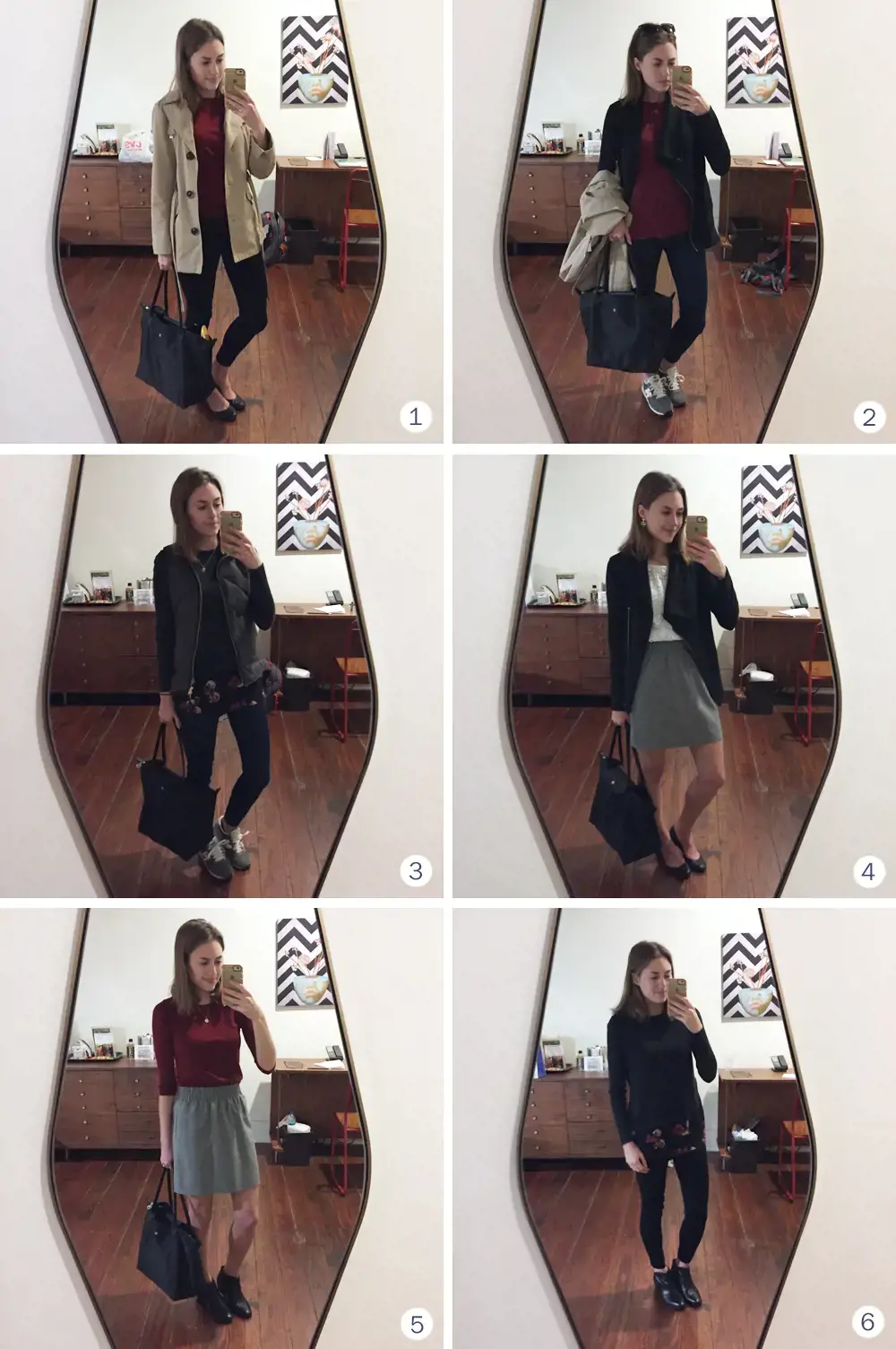
Scientific conferences are formal events where researchers, scientists, and industry professionals come together to present their work, exchange ideas, and collaborate on future projects. As such, they usually have some level of dress code requirements to maintain a professional and respectful environment. While the specifics may vary depending on the conference and the field of study, there are a few general guidelines to keep in mind when choosing your attire for a scientific conference.
- Dress professionally: Scientific conferences are not casual social gatherings, and attendees are expected to dress professionally. This means wearing business attire such as suits, blazers, dress shirts, and dress pants for men, and dresses, skirts, blouses, or dress pantsuits for women. It's always better to be slightly overdressed than underdressed, as a well-put-together appearance demonstrates your seriousness and respect for the event.
- Avoid casual attire: You should steer clear of casual clothing such as t-shirts, jeans, shorts, sneakers, and flip-flops. These are not appropriate for a scientific conference and may give the impression that you lack professionalism or do not take the event seriously. Even if the conference has a more relaxed atmosphere, it's advisable to err on the side of caution and stick to formal attire.
- Consider the conference theme: Some scientific conferences may have a specific theme or focus on a particular field of study. In such cases, it can be a nice touch to incorporate elements of the theme into your outfit. For example, if the conference is related to environmental science, wearing earthy tones or accessories inspired by nature could be a subtle way to show your awareness and engagement with the theme.
- Pay attention to grooming: In addition to choosing appropriate clothing, it's crucial to pay attention to grooming. Make sure your clothes are clean, ironed, and well-fitted. Your hair should be well-groomed, and it's advisable to avoid loud and excessive jewelry or accessories that may distract from the main focus of the conference – your research and contributions to the scientific community.
- Dress comfortably: While it's essential to dress professionally, it's also important to consider comfort, especially if the conference lasts for several days. Opt for comfortable shoes that you can walk or stand in for long periods, as scientific conferences often involve moving between different sessions, poster presentations, and networking events. Additionally, choose clothing materials that breathe and allow for ease of movement, as you'll likely be sitting or standing for extended periods.
Examples:
- John is attending a scientific conference in the field of artificial intelligence. He decides to wear a tailored suit, a crisp white shirt, and a tie to project a polished and professional image. He ensures his shoes are comfortable yet stylish, as he knows he'll be on his feet for most of the day presenting his research and networking with other professionals.
- Lisa is attending a technology conference that has a casual dress code. However, she understands the importance of maintaining professionalism and opts for a smart-casual outfit with a blazer, tailored pants, and a blouse. She accessorizes with a statement necklace that symbolizes her interest in the emerging field of virtual reality.
In conclusion, while dress code requirements may vary slightly depending on the specific scientific conference and field of study, it is generally expected that attendees dress professionally. By following the guidelines of professional attire, considering the conference theme, paying attention to grooming, and prioritizing comfort, you can ensure that you make a positive impression and create meaningful connections at scientific conferences.
Hurstville Maternity: Essential Items to Pack for a Smooth Birth Experience
You may want to see also

Should I bring my laptop or tablet to a scientific conference?
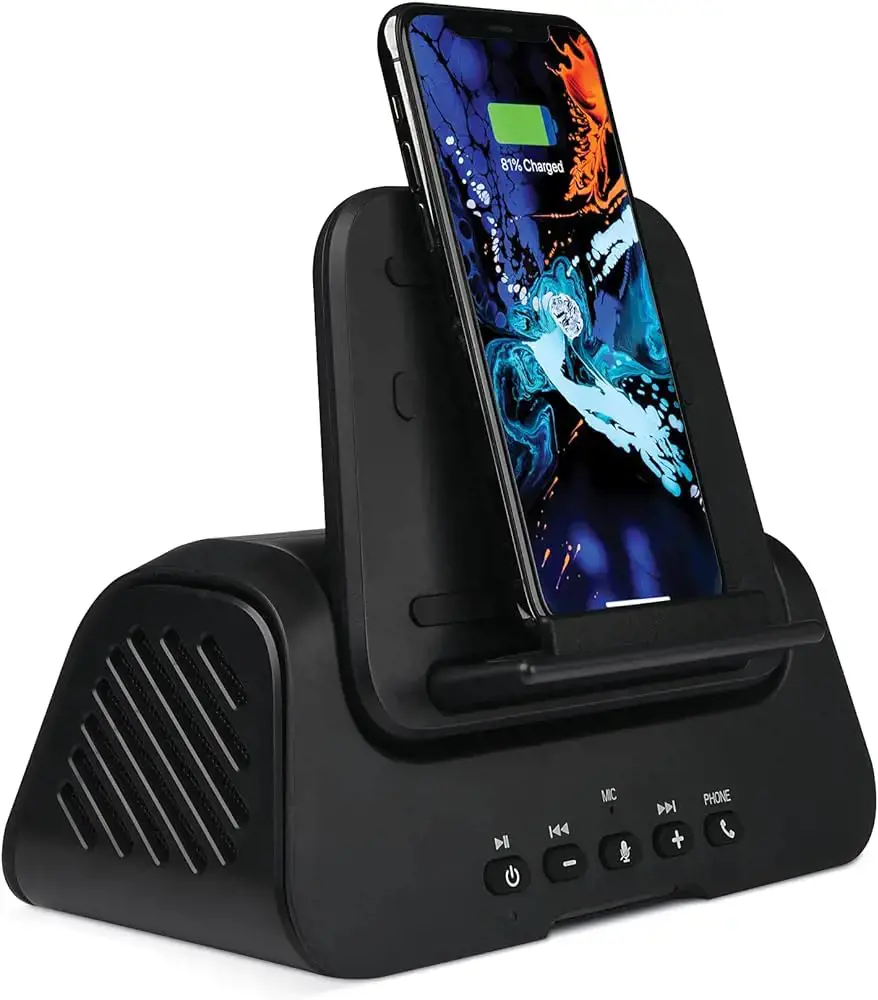
During a scientific conference, it can be beneficial to have a portable device such as a laptop or tablet with you. These devices can enhance your conference experience by allowing you to take notes, access relevant resources, and connect with other attendees. However, choosing between a laptop and a tablet depends on your specific needs and preferences. In this article, we will discuss the pros and cons of bringing a laptop or tablet to a scientific conference, as well as provide guidance on how to make the best decision.
Note-taking capabilities:
Both laptops and tablets offer note-taking capabilities, but the user experience may differ. Laptops typically have physical keyboards, making it easier to type and take detailed notes. Tablets, on the other hand, are more portable and allow for handwritten notes using a stylus or digital pen. Consider your preferred method of note-taking and the importance of detailed notes when making your decision.
Accessibility to resources:
Scientific conferences often provide attendees with access to online resources such as research papers, presentation slides, and additional materials. Having a laptop or tablet enables you to easily access and download these resources on the go. However, keep in mind that some conferences may have limited Wi-Fi connectivity, so it is advisable to download the necessary materials in advance if you choose to bring a tablet.
Connectivity and networking:
Both laptops and tablets allow you to connect with other conference attendees and network effectively. Laptops offer a more comprehensive platform for communication, as they often come with built-in webcams, microphones, and a full desktop experience. Tablets, on the other hand, are more portable and can facilitate informal conversations and networking during breaks or social events. Consider your networking goals and the importance of multimedia features when deciding which device to bring.
Battery life:
Battery life is a crucial factor to consider when attending a conference. While laptops generally have a longer battery life than tablets, they also tend to be heavier and bulkier. Tablets, on the other hand, are lighter and more compact, but may have shorter battery life. If you anticipate long days at the conference with limited access to charging points, a laptop might be a better choice. Otherwise, a tablet could provide sufficient battery life for your needs.
Physical comfort:
Attending a conference often requires spending long hours sitting in lectures or workshops. It is important to consider the physical comfort of the device you choose to bring. Laptops can be heavier and less ergonomic, whereas tablets are lighter and more portable. If you experience discomfort using a laptop for extended periods, a tablet might be a more suitable option.
In conclusion, deciding whether to bring a laptop or tablet to a scientific conference depends on your personal preferences and specific needs. Laptops offer a more comprehensive platform for note-taking, resource accessibility, and networking, but they are bulkier and have shorter battery life. Tablets are more portable, convenient for handwritten notes, and have longer battery life, but they may have limitations when it comes to multitasking and connectivity. Consider the factors mentioned above and choose the device that aligns best with your individual requirements to make the most of your conference experience.
Essential Packing Tips for Visiting Maine in June
You may want to see also

What type of footwear is most suitable for a scientific conference?
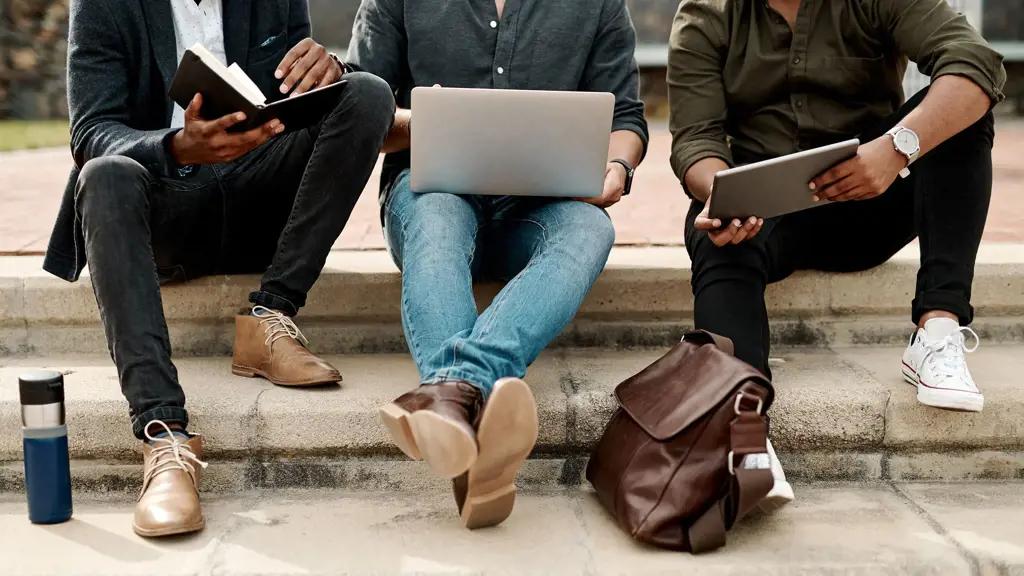
Attending a scientific conference involves a lot of walking, standing, and networking. Choosing the right pair of footwear is essential to ensure comfort and avoid any unnecessary distractions during the event. Here, we will discuss the most suitable type of footwear for a scientific conference, taking into consideration scientific research and personal experience.
Comfort is Key:
When selecting footwear for a scientific conference, prioritizing comfort is crucial. Look for shoes that provide adequate support to your feet, especially if you expect to spend long hours standing or walking. Cushioned insoles, arch support, and ample room for toes are features to consider.
Scientific research has shown that wearing comfortable shoes can have a positive impact on overall foot health. A study conducted by the College of Podiatry in the UK found that individuals who wore comfortable shoes experienced lower levels of foot pain and were less likely to develop foot-related problems.
Opt for Closed-Toe Shoes:
Closed-toe shoes are generally more appropriate for scientific conferences. They provide protection for your feet, particularly in crowded areas where accidental bumps or spills may occur. Additionally, closed-toe shoes give off a more professional appearance and are suitable for both indoor and outdoor venues.
Choose Breathable Materials:
Attending a conference often involves spending extended periods of time on your feet, moving from one session to another. Breathable materials, such as leather or mesh, help to reduce the likelihood of excessive sweating and discomfort associated with moisture build-up. Adequate air circulation can prevent the development of foot odor and maintain overall foot hygiene.
Consider Business Casual Style:
Although comfort is important, it is also essential to maintain a professional appearance at scientific conferences. Opt for footwear that complements your overall business casual attire. Suede or leather loafers, Oxford shoes, or flats are suitable options that can be paired with dress pants, skirts, or dresses.
Avoid High Heels:
While high heels may be fashionable, wearing them to a scientific conference can be impractical and uncomfortable. High heels may cause foot pain, instability while walking, and increase the risk of tripping or falling. It is best to opt for shoes with a lower heel height or choose flats for maximum comfort and stability.
Personal experiences from fellow conference attendees also shed light on the most suitable footwear choices. Many researchers and scientists endorse wearing comfortable walking shoes or sneakers, as they provide adequate support for long hours on your feet. Some even opt for memory foam insoles to further enhance comfort.
To summarize, when selecting footwear for a scientific conference, prioritize comfort, choose closed-toe shoes made of breathable materials, and consider a business casual style. Avoid high heels and instead opt for shoes that provide stability and support. By selecting the appropriate footwear, you can ensure comfort and focus on the scientific discussions and networking opportunities without distractions.
Essential Items to Pack for Your Trip to Canada
You may want to see also

Are there any recommended items to bring for networking and socializing at a scientific conference?
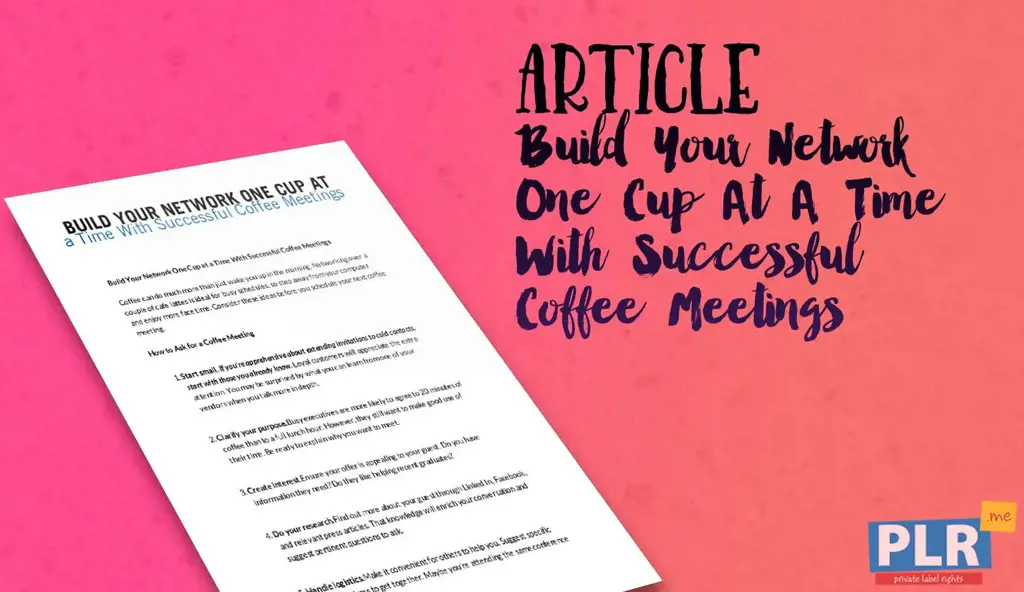
Scientific conferences provide a valuable opportunity for researchers to network and exchange ideas in their field of study. Attending these conferences can be overwhelming, especially for those who are new to the scientific community. However, with some planning and preparation, one can make the most of these events and build useful connections. In this article, we will discuss some recommended items to bring for networking and socializing at a scientific conference.
- Business cards: Business cards are a must-have item for any professional event, including scientific conferences. Your business card should include your name, designation, contact information, and professional affiliations. Handing out business cards makes it easy for people to remember your name and contact you later for collaboration or further discussions.
- Personalized nametag: Many conferences provide nametags upon registration, but it can be helpful to bring your own personalized nametag as well. This allows you to include additional information such as your research interests or a catchy phrase that can attract attention and initiate conversations.
- Elevator pitch: Prepare a concise and engaging elevator pitch about your research. This is a short summary that highlights the main points of your work and its significance. Having a well-practiced elevator pitch will make it easier for you to introduce yourself and engage in conversations with fellow scientists.
- Printed copies of your research: Apart from presenting your work digitally, it can be beneficial to have printed copies of your research to hand out to interested parties. This allows people to delve deeper into your work and provides a tangible reminder of your research when they return home from the conference.
- Comfortable shoes: Conferences often involve a lot of walking and standing, so comfortable shoes are essential to avoid discomfort and fatigue. Opt for shoes that are both professional and comfortable, as you want to make a good impression while also being able to move around easily.
- Breath mints or gum: Networking often involves close interactions and conversations with colleagues, so it is important to maintain fresh breath. Carrying breath mints or gum can help you feel confident and make a positive impression during conversations.
- Notebook and pen: While digital note-taking is becoming increasingly popular, having a notebook and pen can be handy for jotting down important points, ideas, or contact information during presentations or discussions. It is also a good backup in case of technical difficulties with your electronic devices.
- Smartphone and charger: Smartphones are essential for staying connected, accessing conference apps, and keeping track of the conference schedule. Make sure to bring a charger or power bank to keep your phone charged throughout the day.
- Water bottle and snacks: Conferences can be long and tiring, so it is important to stay hydrated and energized. Bringing a reusable water bottle and some healthy snacks can help you stay focused and maintain your energy levels throughout the day.
- Positive attitude: Lastly, it is important to bring a positive attitude and an open mind to the conference. Networking can be intimidating, but approaching conversations with enthusiasm and genuine interest in others' work can go a long way in establishing meaningful connections.
In conclusion, attending a scientific conference can provide numerous opportunities for networking and socializing with researchers in your field. By bringing the recommended items mentioned above, you can maximize your networking potential and make the most of your conference experience. Remember to be prepared, engage in conversations, and be open to new connections and collaborations.
The Ultimate Packing List for Your Hawaii Vacation
You may want to see also
Frequently asked questions
When packing for a scientific conference, it is important to consider the necessities. This typically includes business attire for the duration of the conference, comfortable shoes for long periods of standing or walking, and any presentation materials such as slides or handouts. Additionally, it is helpful to bring a laptop or tablet for taking notes and accessing digital resources.
While most scientific conferences provide the necessary technology for presentations, it can still be beneficial to bring your own equipment. This may include a USB drive with backup copies of your presentation, a personal laptop for easy access to your files, and any specialized equipment or materials needed for your specific research or demonstration. It is always recommended to check with the conference organizers beforehand to ensure you have everything you need.
In addition to professional and technological items, it is important to remember personal essentials when packing for a scientific conference. This includes items such as toiletries, any necessary prescription medications, a small first aid kit, and comfortable clothing for non-conference activities. It is also helpful to pack a reusable water bottle and snacks for times when meals may not be readily available.







